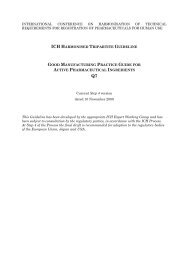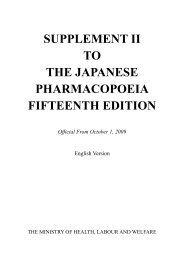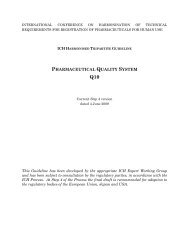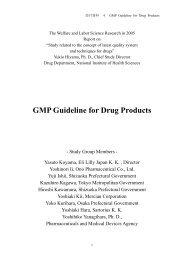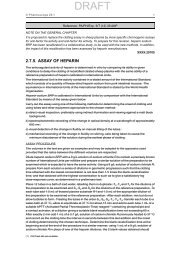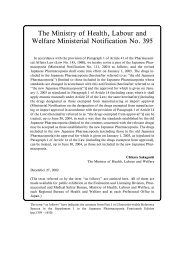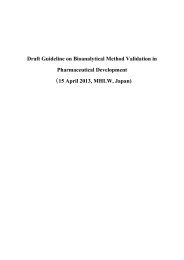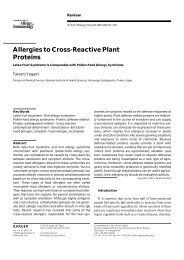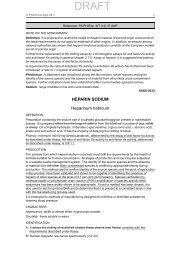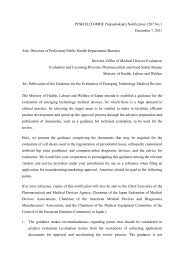OPS/OC/ONDQA/OGD - NIHS
OPS/OC/ONDQA/OGD - NIHS
OPS/OC/ONDQA/OGD - NIHS
You also want an ePaper? Increase the reach of your titles
YUMPU automatically turns print PDFs into web optimized ePapers that Google loves.
添 付 資 料 3 FDA visit agenda<br />
October l and 2,2007<br />
<br />
<br />
<br />
Yukio Hiyama, Ph.D.<br />
Chief, Third Section, Division of Drugs<br />
National Institute of Health Sciences<br />
1-18-l Kamiyohga, Setagayaku, Tokyo 158-8501<br />
<br />
8:30 Transit to Office of Compliance<br />
9:00 Introductions and Manager Discussions<br />
9:30 Pre-approval Inspection<br />
Helen Winkle<br />
Jon Clark<br />
Ted Sherwood<br />
David Morley<br />
Deb Autor<br />
Joe Famulare<br />
Rick Friedman<br />
Alicia Mozzachio<br />
Doug Campbell<br />
l0:15 Break<br />
10:30 CGMP Conformance / Surveillance Inspection<br />
Alicia Mozzachio<br />
Doug Campbell<br />
I l:00 Inspection Site Selection Model: Design and Operation<br />
1l:30 Closing Remarks and Discussion<br />
Gregg Claycamp PhD<br />
Deb Autor<br />
Joe Famulare<br />
Rick Friedman<br />
12:00 Lunch with <strong>OC</strong><br />
12:45 Transit to <strong>OGD</strong><br />
1:00 Generic Drug Application Review Process and Practices<br />
Role of USP standards in review<br />
<strong>OGD</strong> Question Based Review<br />
Rick Friedman<br />
Gary Buehler<br />
2:30 Break<br />
1
添 付 資 料 3 FDA visit agenda<br />
2:45 Discussion / Q&A<br />
4:00 Adjourn<br />
4:30 Dinner (with Moheb and other FDA managers)<br />
Day 2<br />
8:30 <strong>ONDQA</strong> Overview<br />
NDA Review Process<br />
CMC Pilot<br />
10:00 Seminar (Research or Regulatory Topic)<br />
Conference Room 2205<br />
<br />
Yukio Hiyama<br />
11:00 Q & A<br />
11:30 Lunch<br />
1:00 Division of Pre-marketing Assessment I<br />
2:00 Division of Pre-marketing Assessment II<br />
Moheb, Chi-wan, Arzu, DDs<br />
Blair Fraser<br />
Ramesh Sood<br />
Ali Al-Hakim<br />
Elaine Morefield<br />
Moo-Jhong Rhee<br />
Norm Schmuff<br />
3:00 Break<br />
3:15 Division of Pre-marketing Assessment III<br />
and Manufacturing Science<br />
4:15 Division of Post-marketing Evaluation<br />
5:15 Wrap-up<br />
Rik t ostritto<br />
Ravi Harapanhalli<br />
Christine Moore<br />
Eric Duffy<br />
Jim Vidra<br />
Hasmukh Patel<br />
Moheb Nasr / Chi-wan Chen<br />
2
添 付 資 料 4-a FDA 後 発 医 薬 品 審 査 部 門 の 概 要<br />
An Overview<br />
of the<br />
Office of Generic Drugs<br />
Timothy Ames, R.Ph., M.P.H.<br />
Chief, Review Support Branch<br />
Office of Generic Drugs<br />
October 1,2007<br />
regulatory process, that generic drugs<br />
are safe and effective for the<br />
American public.
添 付 資 料 4-a FDA 後 発 医 薬 品 審 査 部 門 の 概 要<br />
[)id yoLr know that generic drugs...<br />
I Are safe and effective alternatives to brand name<br />
prescriptions<br />
I Can help both consumers and the government<br />
reduce the cost of prescription drugs<br />
I Generics represent 63oh of the total prescriptions<br />
dispensed in the US, but only 20o/o of all dollars<br />
spent on prescription drugs. *<br />
I Save approximately $53 for every prescription sold.<br />
{Source: Generic Pharmaceutical Association, GPhA Praises House Subcommittee for<br />
Increasing Funding for Office of Generic Drugsbout Generic Phamaceuticals,T /25/07.<br />
http:/ /w.gphaonline.org<br />
Breakdown<br />
I Total<br />
of lrl'Es - Otfice of Generic Drugs<br />
r Chemists<br />
r Bioequivalence/Pharmacologists<br />
I Pharmacist/Project Managers<br />
I Medical Officers<br />
r Math Statisticians<br />
I Microbiologists<br />
2t4<br />
84<br />
32<br />
66<br />
a<br />
J<br />
3*<br />
8<br />
r IT Specialists<br />
r Admin/Support Staff<br />
2<br />
19<br />
*(do not belong to <strong>OGD</strong>)
添 付 資 料 4-a FDA 後 発 医 薬 品 審 査 部 門 の 概 要<br />
<br />
<br />
<br />
<br />
Review and Approve Abbreviated New Drug<br />
Applications(ANDAs)/Supplements<br />
Provide Regulatory/Technical Guidance to Industry<br />
(Controlled Documents)<br />
Address Scientific Issues concerning Generic Drug<br />
Products (Citizens' Petitions, etc.)<br />
Develop/Improve Review Processes for ANDAs<br />
Educate & Train a diverse staff in latest Scientific,<br />
Regulatory, and Review technologies<br />
Educate American Public about FDA approved Generic<br />
Drug Products<br />
Otl-ice of Generic Drugs<br />
I)ircc tor<br />
Gary Buehler, R.Ph.<br />
I )ireel,rl lor Scicnee<br />
Lawrence Yu. Ph.D.<br />
l)cprrtr l)irect()r<br />
Robert West, R.Ph<br />
\\\(ltinlc l)ireflor<br />
for \lrdical \llrir.<br />
Dena Hixon, M.D.<br />
\srocilte l)ircctor lirr<br />
()tttrrlirrns rnd<br />
( ornutuniratioor<br />
Rita Hassall, RN, MN<br />
\ | ic robiologr<br />
Re r it'rr I ur tn<br />
Neal Sweeney, Ph.D.<br />
\sroeiatc l)irr.rtor<br />
firr'( lrcnristrr<br />
Frank Holcombe, Ph.D<br />
l )r r rclot<br />
)ir iriorr ol'l ahclir<br />
[)rrc!l()r<br />
I )ir r.irrrr ol'<br />
( ircnri:trr i<br />
Rashmi Patel, Ph.D<br />
I )i reetor<br />
I )ir isjrrrt rrl'<br />
( lrenrr:trr l l<br />
Florence Fang<br />
I lircetor<br />
I)ir r:irrr ol<br />
( lrenrr.trr III<br />
Vilayat Sayeed, Ph.D<br />
I )i r trt()l<br />
l)ir i:irrrt rrl'<br />
llii)equi\ rlrll.c
添 付 資 料 4-a FDA 後 発 医 薬 品 審 査 部 門 の 概 要<br />
Division of Labeling &<br />
Program Support<br />
W. Petcr Ricl..rlan<br />
[) ircctor<br />
' \ lteillti'<br />
I)el)ilt\ I)ilcc1()r<br />
r<br />
Ilcr it'u SupJrolt llrant h<br />
I inr ,\nre'<br />
llr. ( hicl'<br />
liegulalorr Supltort llranch<br />
( l)l{ \lrrtin \hirnrr<br />
llr. ( hicf<br />
()rilngc l]0(,L Slrfl<br />
l{oltrt Rtint ald<br />
I clnt l.earlrr'<br />
l.abelinq learn I<br />
( .\l) I l.illie (irtlsrrn<br />
I crrrr l.cirrlcr'<br />
I rbelirg'l canr 2<br />
,lobn (irace<br />
I crnr I cadtr<br />
<br />
Division of Chemistry I<br />
[{ashnri l'ate l. l)h.D.<br />
I ) ircctrir'<br />
l)aLrl Sch*artz. l)h.l)<br />
i)epulr I)ltcclirt<br />
I elnr I<br />
\lltcrt \lut,ller'. l)h.l).<br />
I eln l.cirrlcr<br />
I tarn l<br />
\likr Snrcla<br />
I trnr l.cadrr<br />
Itrnr .i<br />
.lrnrtr I rn<br />
l c:trn l.crrler<br />
I eanr 5<br />
l{ri l}r ladi. I'lr.t).<br />
I eanr I crrlt'r<br />
Team numbere are COMIS designations
添 付 資 料 4-a FDA 後 発 医 薬 品 審 査 部 門 の 概 要<br />
Division of Chemistry II<br />
Frlclrerrcc l:ang<br />
I)ilcctor'<br />
Riclrard Adanrs<br />
l)cprrtr l)rrrctor<br />
Ieam I<br />
\1. Scott l;urncss. I'h.l)<br />
'I earl I c:rrler<br />
I rrnr ll<br />
t br;rni \ cnk:rtarrnr. Ith.l)-<br />
I carn l.carler<br />
'I cxnr ')<br />
(ilen.l. \nrith<br />
-l<br />
clrn [.tarlcr<br />
I crnt lll<br />
\aiqi \ a, l'h.l),<br />
I eant l,crrlrr<br />
Team numbers are COMIS designations<br />
<br />
Division of Chemistry III<br />
Vilarat Savccci. Ph.D.<br />
I)ircctor<br />
I r'rnt J<br />
[)er irrtltr' (,ill. I'h.l].<br />
l earl |.crdcr<br />
I carn (r<br />
\rrran Zrrk. I>h,l). L,'erinl<br />
I tanr l.cader<br />
Icrnr ll<br />
\hin!: I l. I iu. I'h.l)<br />
I crlt l.errlt r<br />
lerrtt ll<br />
I lorreirr hhorrhirli<br />
I canr I crrlt,r<br />
Team numbers are COMIS desgnations
添 付 資 料 4-a FDA 後 発 医 薬 品 審 査 部 門 の 概 要<br />
Division of B ioequivalence<br />
[)ale ('onncr. Pharnr.l).<br />
D ircctor<br />
Balbara I)avit. l'}h.l)<br />
l)cprrtr I)tlect0r<br />
t-<br />
l(.r ( ir,jL t<br />
L ) \ ,:i \!, (t.i<br />
I trnt J<br />
har(lri ( hrurr\ii. l'h.l<br />
I canr I eadrr<br />
I crnr 5<br />
Kuldctp l)harirrrl. l'h.l)<br />
I cenr l.rrdcr<br />
I carr 2<br />
nlr \trrrlLrr, llh.l<br />
I t'atr l.r'arlcr<br />
I rant 'l<br />
\ ih-( hain lluang, l)h.l).<br />
I crnr |.rltler<br />
I canr I<br />
\lohtb \lakarr, l'h.l).<br />
I tllt I errdcr<br />
()lTice of (ientric I)rugs<br />
<br />
Receipts of Original A-\D-{s<br />
<br />
<br />
<br />
<br />
<br />
<br />
<br />
<br />
<br />
<br />
<br />
<br />
<br />
<br />
<br />
<br />
<br />
<br />
<br />
<br />
2003 200rt<br />
Fisc*l 1'ear<br />
(" = Projected)
添 付 資 料 4-a FDA 後 発 医 薬 品 審 査 部 門 の 概 要<br />
Approvals and Tentative Approvals<br />
<br />
<br />
<br />
<br />
<br />
<br />
t00-1 200,t<br />
Fiscal Year<br />
<br />
<br />
<br />
<br />
<br />
Appror,'al Tirlcs - Median
添 付 資 料 4-a FDA 後 発 医 薬 品 審 査 部 門 の 概 要<br />
<br />
<br />
<br />
<br />
<br />
<br />
U Receipts of Chemistry Supplements<br />
I Chemistry Supplements Approved<br />
f Chemistry Supptemsnts Not Approved<br />
<br />
<br />
<br />
<br />
FiscalYear Totals<br />
<br />
<br />
<br />
<br />
<br />
2003 2004 2005 2006<br />
Calendar Year<br />
<br />
<br />
( * = Projected Figures )
添 付 資 料 4-a FDA 後 発 医 薬 品 審 査 部 門 の 概 要
添 付 資 料 4-a FDA 後 発 医 薬 品 審 査 部 門 の 概 要<br />
NI)A vs.<br />
ANDA Revieu' Process<br />
Brand Narne Drug<br />
Generic Drug<br />
NDA Requirernents ANDA Requirernents<br />
1. Chemistry<br />
2. Manufacturing<br />
3. Controls<br />
4. Labeling<br />
5. Testing<br />
6.<br />
7.<br />
8.<br />
1. Chemistry<br />
2. Manufacturing<br />
3. Controls<br />
4. Labeling<br />
5. Testing<br />
6. Bioequivalence<br />
NDA vs. ANDA Revierv Process<br />
r NDA Review : Lower volume (ave.25<br />
approvals/year), but Higher Complexity<br />
(Pre-Clinical, Clinical Trials, etc.)<br />
r ANDA Review : Higher volume (425<br />
approvalsiyear), but Lower Complexity<br />
(Safety & Efficacy already established)
添 付 資 料 4-a FDA 後 発 医 薬 品 審 査 部 門 の 概 要<br />
Generic<br />
Drug<br />
Review<br />
Process<br />
Manufacturing Compliance Programs tffii<br />
\{4!J/<br />
r Purpose - To assure quality of marketed<br />
drug products<br />
r Mechanisms - Product Testing<br />
I Surveillance<br />
t Manufacturing/Testing Site Inspections @ERs)<br />
I Assess firm's compliance with good<br />
manufacturing/l aboratory processe s
添 付 資 料 4-a FDA 後 発 医 薬 品 審 査 部 門 の 概 要<br />
Chenristry Revreu,<br />
r Components and composition<br />
r Manufacturing and controls<br />
r Batch formulation and records<br />
r Description of facilities<br />
r Specs and tests<br />
r Packaging<br />
r Stability<br />
<br />
<br />
r "Same" as brand name labeling<br />
r May delete portions of labeling protected by<br />
patent or exclusivity<br />
r May differ in excipients, PK data and how<br />
supplied
添 付 資 料 4-a FDA 後 発 医 薬 品 審 査 部 門 の 概 要<br />
Deflrrition of B ioecluivalence (BE)<br />
<br />
Pharmaceutical equivalents whose rate and<br />
extent of absorption are not statistically<br />
different when administered to patients or<br />
subjects at the same molar dose under<br />
similar experimental conditions<br />
Purpose of BE Revierv<br />
<br />
r Therapeutic equivalence (TE)<br />
r Bioequivalent products can be substituted<br />
for each other without any adjustment in<br />
dose or other additional therapeutic<br />
monitoring<br />
r The most efficient method of assuring TE, is<br />
to assure that the formulations perform in an<br />
equivalent manner
添 付 資 料 4-a FDA 後 発 医 薬 品 審 査 部 門 の 概 要<br />
<br />
<br />
r Dr. Dena Hixon, M.D.<br />
r Reviews bioequivalence studies with clinical<br />
endpoints<br />
r Evaluates safety issues (inactive ingredients,<br />
adverse events, etc.)<br />
I Assesses clinical issues in ANDAs (effect of<br />
different vehicles, inactive ingredients)<br />
I Assesses equivalence challenges<br />
<br />
<strong>OGD</strong> Proiect Managcr Role<br />
r Discipline specific PMs<br />
r Review process based on First-In - First-<br />
Reviewed - Not PDUFA<br />
r Chemistry review drives the review process;<br />
hence, Chemistry PM monitors overall<br />
review progress<br />
I Ex: Informs BioequivalenceAvlicrobiology PM<br />
of need for reviews<br />
o Prepares fulI approval package
添 付 資 料 4-a FDA 後 発 医 薬 品 審 査 部 門 の 概 要<br />
<strong>OGD</strong> Project Managcr Role<br />
r Bioequivalence PM<br />
t Controlled correspondence<br />
r Bioequivalence waiver requests<br />
r Bioequivalence review queues<br />
r Microbiology PM<br />
t Monitors review queue<br />
0 Assures ANDAs needing microbiology review<br />
are identified<br />
<strong>OGD</strong> Project Managcr tlole<br />
r All fulfill other traditional PM functions,<br />
e.9., communication with industry, assuring<br />
all actions are documented
添 付 資 料 4-a FDA 後 発 医 薬 品 審 査 部 門 の 概 要<br />
Research Initiatives by <strong>OGD</strong> Scientific Staff<br />
La',vrence Yu, Ph.D., I)irector fbr Science<br />
r Respond to Scientific Challenges<br />
r Develop Bioequivalence Methods<br />
I MDIs<br />
I Topicals<br />
r Injectable Suspensions<br />
r Expand In-House Capabilities<br />
r Work with Office Testing & Research in<br />
developing/hiring expertise<br />
r External Contracts<br />
u'Orange Book Staff"<br />
"Approved Drug Products with Therapeutic<br />
Equivalence Evaluations"<br />
A11 FDA approved drug products listed<br />
(NDA's, OTC's & ANDA's)<br />
I Therapeutic equivalence codes<br />
)"A" : Substitutable<br />
t'68" - Inequivalent, NOT Substitutable<br />
I Expiration dates: patent and exclusivity<br />
o Reference Listed Drugs/brand drugs identified by FDA<br />
for generic companies to compare with their proposed<br />
products
添 付 資 料 4-a FDA 後 発 医 薬 品 審 査 部 門 の 概 要<br />
<strong>OGD</strong> Education Comnrittee<br />
r Purpose -<br />
To provide educational offerings<br />
for the <strong>OGD</strong> staff including training and<br />
plant visits<br />
I Committee has at least one member from<br />
each <strong>OGD</strong> review discipline<br />
r Plant trips<br />
r <strong>OGD</strong> Reviewer Forum<br />
I Workshops -<br />
Open to others on space<br />
available basis<br />
Ner,v Drug Rer,'ieu,' Divisions Itrteracticlns u'ith<br />
<strong>OGD</strong><br />
r Bundled Reviews<br />
I Consults<br />
r Risk Management/Educational Programs<br />
I Labeling Supplements<br />
I Best Pharmaceuticals for Children Act (BPCA)<br />
r <strong>OGD</strong> Website -<br />
Contact list
添 付 資 料 4-a FDA 後 発 医 薬 品 審 査 部 門 の 概 要<br />
<br />
<br />
<br />
<br />
<br />
<br />
<br />
<br />
<br />
<br />
<br />
<br />
<br />
<br />
<br />
<br />
<br />
<br />
//-':^;.<br />
va,ent to a brand name<br />
-".; -equ<br />
drug in dosage form. saf€tv. stcngth, rod. d admihEranon.<br />
qualilv. petrormnce chatacterstics and inteod€d use<br />
Anhough generic drugs are chemicallv identical lo lher<br />
branded cilnt€rparts lhev at€ tvPlcalt sold at sub*ailial<br />
discounl5 fonr th€ br.oded price- &cdding to th€<br />
Congressional &dget Otrce geredc *ugs s:te consw€rs<br />
an eiimaled s8 to $10 bllion a v€ar at reta{ pbrmacies<br />
Evs mde hllons 3r. saved tri hspilals us. g.ndics<br />
<strong>OGD</strong><br />
Website<br />
ftsyftra\GIdF<br />
!k.r.r,l 4 ltbd jJr&tuJ-1'J3' jl .d<br />
&bq@@,<br />
ohl<br />
<br />
<br />
<br />
<br />
<br />
product, the petition is approved. il t is not sufrable, the pettrion is denied<br />
Organization and Conlact Infomation<br />
. Chem,5tr/ Rerew I:asr!for lr!!*erac!tc crl:991.s<br />
. afilce ni Genen. Druqs fel4phone Jtr.clory<br />
Freedom of lnfomation<br />
. I i. l,er JJ I ii iif.i r'rd: . I ie! !t;!: proudes access to infomatron<br />
from adisory commilees clinical iNestigato6; the Divsion of Drug<br />
Marketing, Advenising and communications corespondence; drug<br />
approval packages; and Mming letlers.<br />
How to Contact Ua<br />
<br />
We ask you to take time to communicate with CDER abod this website. What<br />
ifformalion is and isn't useful to you Are there any addfrional nems or<br />
categories of infomatron you would like us to add Please email limotlry W<br />
Anes, lrrtirt am€s@'3. iN5 !o! with fedback abod lhis site.<br />
<br />
tea!!i. ilp t gack!! Jfi fe" ind lN,!:rs
添 付 資 料 4-a FDA 後 発 医 薬 品 審 査 部 門 の 概 要<br />
<strong>OGD</strong><br />
Website<br />
<br />
<br />
<br />
<br />
<br />
<br />
<br />
<br />
<br />
-i!b r-dsrd&:16.q: S. Odn*- ft - rM' .,<br />
@619h@/tur&s\<br />
l.rrv-r.,, r' I d)rli11 :r,,1 1'r,! ai n{trlr<br />
Ollice ofCcncric Drug\<br />
l)lrjrLJ jtrrJ!1,ir\<br />
<br />
<br />
<br />
<br />
i$ramm
添 付 資 料 4-b FDA 後 発 医 薬 品 審 査 と 米 国 薬 局 方<br />
Impact of USP Monographs<br />
on the<br />
Ollice of Generic Drugs<br />
Review Process<br />
October 1,2007<br />
Frsnk O. Holcombe, Jr.' Ph.D.<br />
Associate Director for Chemistry<br />
Ollice of Generic Drugs<br />
USP/I\F<br />
United States Pharmacopeial Convention<br />
. Promote Public Health Through Authoritative<br />
Standards and Information<br />
. United States Pharmacopeia and National<br />
Formulara<br />
. Independent<br />
. Public Process<br />
. Non-Governmental
添 付 資 料 4-b FDA 後 発 医 薬 品 審 査 と 米 国 薬 局 方<br />
United States Pharmacopeia & National Formulary<br />
The Official Compendia of Standards<br />
Organization<br />
. General Notices<br />
. Ofiicial Monographs<br />
. General Chapters<br />
National Formulary<br />
USPAIF<br />
Monographs<br />
' :*"ililstance<br />
Inactive Ingredient (excipients)<br />
Drug Product<br />
'<br />
:*""T;t t.T,T':::1"-n."u,ar Monographs
添 付 資 料 4-b FDA 後 発 医 薬 品 審 査 と 米 国 薬 局 方<br />
USPAiF<br />
Monograph<br />
Drug Substance Parameter Examples<br />
. * Description<br />
o * Packaging and Storage<br />
. * Reference Standards (as available)<br />
. * Identification<br />
. Residue on Ignition<br />
. HeaYy Metals<br />
. Organic Volatile Impurities<br />
. Chromatographic Purity<br />
. Water/Loss on Drying<br />
. * Assay<br />
USPAIF<br />
Monograph<br />
Drug Product Parameter Examples<br />
. * Description<br />
. * Packaging and Storage<br />
. * Reference Standards (as available)<br />
. * Identification<br />
pH<br />
Dissolution<br />
* Uniformity of Dosage Units<br />
Related Compounds<br />
Water/Loss on Drying<br />
* Assay
添 付 資 料 4-b FDA 後 発 医 薬 品 審 査 と 米 国 薬 局 方<br />
USPAIF<br />
Food Drug and Cosmetic Act<br />
Section 201 (g)(1) - sdrug" means<br />
. (A) articles recognized in the oflicial United States<br />
Pharmacopeia, ... National Formulary....<br />
. (D)articles intended for use as a component of any<br />
articles sPecified in (A)....<br />
- Section 501(b) - Adulterated Drugs<br />
. Strength, QualitY' PuritY<br />
Section 502(e)' (g) - Misbranded Drugs<br />
. Established Name; Packaging<br />
USPAIF<br />
Title 21 - Code of Federal Regulations<br />
Section 314.50(dxl) - Chemistry, manufacturing, and controls<br />
. Drug Product, Drug Substance -<br />
. Reference to ... U.S. Pharmacopeia ... may<br />
satisfy relevant requirements of this paragraph.<br />
Section 314.50(e) - Samples and labeling<br />
. Reference standards recognized ... oflicial<br />
compendium...
添 付 資 料 4-b FDA 後 発 医 薬 品 審 査 と 米 国 薬 局 方<br />
<br />
<br />
<br />
<br />
<br />
<br />
<br />
<br />
<br />
<br />
<br />
<br />
<br />
Application Review Goals<br />
<br />
Concerns - IdentitY<br />
<br />
<br />
<br />
- QuatitY<br />
- Strength<br />
- Purify<br />
- Bioequivalence<br />
Provides -<br />
Tests Evaluate<br />
Methods<br />
Acceptance Criteria<br />
- Tests<br />
- Methods<br />
- Acceptance Criteria
添 付 資 料 4-b FDA 後 発 医 薬 品 審 査 と 米 国 薬 局 方<br />
USPAIF<br />
Application Review Goals<br />
Additional Concerns<br />
- Manufacturing<br />
- Development<br />
- Scale Up<br />
- Non-USP materials<br />
- Non-USP attributes<br />
USPATF<br />
Review Process<br />
. Monograph<br />
' Required Criteria<br />
. Provides Defined Methods<br />
. Provides Basis for Standard Procedures<br />
. Provides Structure for Generalized Acceptance<br />
Criteria<br />
o I Partial Basis for Specification Setting
添 付 資 料 4-b FDA 後 発 医 薬 品 審 査 と 米 国 薬 局 方<br />
<br />
<br />
<br />
<br />
<br />
<br />
Defined for Release and'Shelf Life<br />
. Stability Indicating Methods<br />
Criteria are Generally Process-specific<br />
Single source vs Multi-source<br />
. Impurities/Degradants<br />
. Substitution<br />
Multiple Methods<br />
USPAIF<br />
Monograph at Time of Application Approval<br />
Year Drue Substance Drue Product Distinct DS<br />
<br />
<br />
<br />
<br />
<br />
<br />
<br />
<br />
<br />
<br />
<br />
<br />
7o total app)<br />
44 "/"<br />
53 "h<br />
580<br />
68'
添 付 資 料 4-b FDA 後 発 医 薬 品 審 査 と 米 国 薬 局 方<br />
USP/NF<br />
Change Process<br />
Pharmacopeial Forum<br />
Topics - New Monograph<br />
- Revised Monograph<br />
- General Chapters<br />
USPAiF<br />
Change Process<br />
ii<br />
Compendial Operations Staff :<br />
. Monitor USP Proposals<br />
. Information Conduit<br />
. Responsible for Official Comment<br />
. Formal Contact with USP
Question-based Review:<br />
Implementing Quality by Design<br />
Lawrence X. Yu, Ph.D.<br />
Director for Science<br />
Office of Generic Drugs, <strong>OPS</strong>, CDER<br />
Food and Drug Administration<br />
Opinions expressed in this presentation are those of the speakers<br />
and do not necessarily reflect the views or policies of the FDA<br />
1
QbR is a System<br />
Generic Drug<br />
Application<br />
Quality by<br />
Design<br />
QbR<br />
Questions<br />
Quality Overall<br />
Summary<br />
Post-marketing<br />
management<br />
2
Pharmaceutical Quality<br />
= ƒ (Drug Substance,<br />
Excipients, Manufacturing,<br />
and Packaging)<br />
3
Janet Woodcock on QbD<br />
J. Woodcock.<br />
Am. Pharm. Rev.,<br />
2004<br />
• Quality by Design “means that<br />
product and process performance<br />
characteristics are scientifically<br />
designed to meet specific<br />
objectives... To achieve QbD<br />
objectives, product and process<br />
characteristics important to<br />
desired performance must be<br />
derived from a combination of<br />
prior knowledge and experimental<br />
assessment during product<br />
development.”<br />
4
ICH Q8 Describes Quality by<br />
Design<br />
• Introduced in ICH Q8<br />
– “quality cannot be tested into products, i.e.,<br />
quality should be built in by design”<br />
• Product Development Report explains<br />
– how drug substance properties and formulation<br />
variables affect the performance of the drug<br />
product<br />
– how the sponsor identifies the critical<br />
manufacturing steps, determines operating<br />
parameters, selects in-process tests to control the<br />
process, and scales up the manufacturing process<br />
5
ISPE PQLI on QbD, Sept. 14, 2007<br />
• Quality by Design is a systematic approach to<br />
development that begins with predefined objectives and<br />
emphasizes product and process understanding based on<br />
sound science and quality risk management. This<br />
approach entails the following aspects:<br />
– Defining the desired product performance, or more generally the<br />
Pharmaceutical Target Product Profile<br />
– Identifying those product characteristics that are Critical Quality<br />
Attributes (CQAs)<br />
– Identifying process parameters and material attributes that can affect<br />
CQAs<br />
– Creating or using an established Knowledge Space to establish one or<br />
more Design Space(s) and an appropriate Control Strategy that reliably<br />
deliver a product that meets requirements<br />
– Incorporating the approach into the business plan, product development<br />
plan, and assuring and enabling it through the Quality System to<br />
facilitate continual improvement throughout the product lifecycle<br />
6
What is Quality by Design<br />
• Quality by Design means<br />
– designing and developing formulations and<br />
manufacturing processes to ensure a<br />
predefined quality<br />
• Quality by Design requires<br />
– understanding how formulation and<br />
manufacturing process variables influence<br />
product quality<br />
• Quality by Design ensures<br />
– Product quality (along with ICH Q9 and Q10)<br />
7
Overview of QbD<br />
Labeled Use<br />
Safety and Efficacy<br />
Knowledge<br />
Space<br />
DEFINE Target<br />
Product Quality Profile<br />
DESIGN Product<br />
Design Process<br />
Design Space<br />
IDENTIFY Critical Material Attributes<br />
& Critical Process Parameters<br />
CONTROL Materials<br />
Control Process<br />
TARGET DESIGN IMPLEMENTATION<br />
8
QbD to an FDA Generic Drug<br />
Reviewer<br />
• Defining target product quality profile<br />
– The performance needed to get clinical benefit and<br />
meet consumer expectation<br />
• Designing product and processes to meet target<br />
product quality profile<br />
• Identifying critical material attributes, process<br />
parameters, and sources of variability<br />
– Design space<br />
• Controlling materials and manufacturing<br />
processes to produce consistent quality over<br />
time<br />
9
Target Product Quality Profile:<br />
Beginning the Drug Development<br />
with the End in Mind<br />
• FDA’s recent guidance on Target Product Profile (TPP)<br />
• The Target Product Quality Profile (TPQP) is a quantitative<br />
surrogate for aspects of clinical safety and efficacy that can be<br />
used to design and optimize a formulation and manufacturing<br />
process<br />
• ISPE PQLI: Pharmaceutical Target Product Profile<br />
• TPQP: Example<br />
– Assay (uniformity)<br />
– Purity<br />
– Stability<br />
– Desired pharmacokinetic profile<br />
• In vitro dissolution<br />
• Bioequivalence<br />
10
Designing Product and Processes<br />
to Meet Target Product Quality<br />
Profile<br />
• Product Design<br />
– Physical, chemical, and biological properties of drug<br />
substance<br />
– Biopharmaceutics Classification System (BCS) and<br />
formulation development<br />
• Process Design<br />
– Mechanical properties, flow properties, and others<br />
– Unit operation selection<br />
– Identification of process parameters and material<br />
attributes<br />
11
Identifying Critical Material Attributes,<br />
Process Parameters, and Sources of<br />
Variability<br />
I<br />
N<br />
P<br />
U<br />
T<br />
S<br />
(X)<br />
Process<br />
Measurement<br />
Material<br />
Environment<br />
Y = ƒ(X)<br />
Priori knowledge<br />
Risk Assessment<br />
Design of<br />
Experiments<br />
Inputs to the process<br />
control variability<br />
of the Output<br />
Y<br />
OUTPUT<br />
Material Attributes<br />
12
Mixing<br />
Process Understanding: An Example<br />
Operating Parameters<br />
Speed<br />
Forces<br />
Depth of fill<br />
Punch penetration depth<br />
Moisture<br />
Feeder<br />
Hopper<br />
Compression<br />
Identity<br />
Assay<br />
Purity/Impurity<br />
Dissolution<br />
(Disintegration)<br />
Material Attributes<br />
Before Compression<br />
Blend uniformity<br />
Particle size<br />
Density<br />
Moisture<br />
Flow Properties<br />
Material Attributes<br />
After Compression<br />
Core tablet weight<br />
Uniformity<br />
Hardness<br />
Thickness<br />
Porosity<br />
Friability<br />
Visual attributes<br />
13
Critical Quality Attribute<br />
• “A critical quality attribute is a physical,<br />
chemical, biological or microbiological<br />
property or characteristic that needs to be<br />
controlled (directly or indirectly) to ensure<br />
product quality.”<br />
• “An attribute is a quality or characteristic<br />
inherent in or ascribed to something. It may be<br />
measurable properties of a material, or<br />
measurable characteristics of the process to<br />
make the material.”<br />
14
Mixing<br />
Process Understanding: An Example<br />
Operating Parameters<br />
Speed<br />
Forces<br />
Depth of fill<br />
Punch penetration depth<br />
Moisture<br />
Feeder<br />
Hopper<br />
Compression<br />
Critical Quality<br />
Attributes<br />
Identity<br />
Assay<br />
Purity/Impurity<br />
Dissolution<br />
(Disintegration)<br />
Material Attributes<br />
Before Compression<br />
Blend uniformity<br />
Particle size<br />
Density<br />
Moisture<br />
Flow Properties<br />
Material Attributes<br />
After Compression<br />
Core tablet weight<br />
Uniformity<br />
Hardness<br />
Thickness<br />
Porosity<br />
Friability<br />
Visual attributes<br />
15
Design Space<br />
• Design Space<br />
– The multidimensional combination and interaction of input<br />
variables (eg. Material attributes) and process parameters that<br />
have been demonstrated to provide assurance of quality.<br />
Working within the design space is not considered as a change.<br />
Movement out of the design space is considered to be a change<br />
and would normally initiate a regulatory postapproval change<br />
process.<br />
• Design space is often<br />
established based on<br />
in vitro “predictive”<br />
dissolution<br />
16
<strong>OGD</strong> on Design Space: A Proposal<br />
• Ranges for input materials and process<br />
parameters if there are no interactions among<br />
them<br />
• Design space can be proposed at the ANDA<br />
filing approval<br />
– Priori knowledge,<br />
– Risk Assessment, and/or<br />
– Design of Experiments<br />
• The proposed design space is subject to post<br />
approval confirmation<br />
– Annual Report<br />
17
Controlling Input Materials and<br />
Manufacturing Processes to Produce<br />
Consistent Quality over Time<br />
Level 1:Target product<br />
quality profile<br />
Level 2: Critical<br />
process parameters<br />
Level 3: Real-time<br />
automatic “engineering<br />
Control”<br />
Level of Control<br />
Level of Freedom<br />
PQLI<br />
Specification versus Control<br />
18
FDA’s Pharmaceutical cGMP<br />
for the 21 st Century<br />
QbD Initiative<br />
Generic Sponsor:<br />
Implementing<br />
QbD in development<br />
and manufacturing<br />
FDA <strong>OGD</strong>:<br />
Developed a Questionbased<br />
Review System<br />
that assesses sponsor’s<br />
QbD ANDAs<br />
19
QbR Questions Provides a<br />
Roadmap<br />
• Questions guide reviewers<br />
– Prepare a consistent and comprehensive evaluation<br />
of the ANDA<br />
– Assess critical formulation & manufacturing<br />
variables<br />
• Questions guide industry<br />
– Recognize issues <strong>OGD</strong> generally considers critical<br />
– Direct industry toward QbD<br />
• Questions inform readers of the review<br />
– How QbD was used in the ANDA<br />
– Provide the basis for a risk assessment<br />
20
How Does QbR Implement QbD<br />
Product Performance<br />
What attributes should the drug<br />
product possess<br />
Answer: What was the goal<br />
Quality<br />
by<br />
Design<br />
What does <strong>OGD</strong> mean by<br />
attributes in this question<br />
Answer: Target product quality<br />
profile such as assay, purity,<br />
dissolution, stability etc.<br />
21
How Does QbR Implement QbD<br />
Product Design<br />
How was the product designed to<br />
have these attributes<br />
Quality<br />
by<br />
Design<br />
Were alternative formulations or<br />
mechanisms investigated<br />
How were the excipients<br />
selected<br />
How was the final formulation<br />
optimized<br />
22
How Does QbR Implement QbD<br />
Process Design<br />
Quality<br />
by<br />
Design<br />
What are the unit operations<br />
in the drug product<br />
manufacturing process<br />
Why was the manufacturing<br />
process selected<br />
How are the unit operations<br />
related to the drug product<br />
quality<br />
23
How Does QbR Implement QbD<br />
Material and Process Identification<br />
Which properties or physical<br />
chemical characteristics of the drug<br />
substance affect drug product<br />
development, manufacture, or<br />
performance<br />
What evidence supports<br />
compatibility between the excipients<br />
and the drug substance<br />
Quality<br />
by<br />
Design<br />
How were the critical process<br />
parameters identified, monitored,<br />
and controlled<br />
24
Critical Material Attribute and<br />
Process Parameter<br />
• A Critical Material Attribute is a physical, chemical,<br />
biological or microbiological property or characteristic of a<br />
material that needs to be controlled (directly or indirectly)<br />
to ensure product quality.<br />
• A Critical Process Parameter is a process parameter whose<br />
variability impacts a quality (material) attribute and<br />
therefore needs to be controlled to ensure the process<br />
produces the desired quality. A critical process parameter<br />
remains critical even if it is controlled.<br />
25
How Does QbR Implement QbD<br />
Process and Input Material Controls<br />
What are the in-process tests and/or<br />
controls that ensure each step is<br />
successful<br />
What is the scale-up experience with the<br />
unit operations in this process<br />
In the proposed scale up plan what<br />
operating parameters will be adjusted to<br />
ensure the product meets all in-process<br />
controls and final product specifications<br />
Quality<br />
by<br />
Design<br />
What evidence supports the plan to scale<br />
up the process to commercial scale<br />
26
QbR Communications<br />
• www.fda.gov/cder/ogd/QbR.htm<br />
– QbR White Paper<br />
– QbR Questions<br />
– QbR Frequently Asked Questions<br />
– QbR mock examples<br />
– QbR updates<br />
• Publications on QbR<br />
– J. Generic Medicine, Pharm. Eng….<br />
• Workshops, Webcast, and Teleconf.<br />
27
Conclusion<br />
• The FDA <strong>OGD</strong> has developed a<br />
Question-based Review for quality<br />
assessment. It is a concrete and practical<br />
implementation of the underlying<br />
concepts and principles outlined by the<br />
FDA’s Pharmaceutical CGMPs for the<br />
21st Century and Quality by Design<br />
(QbD) initiatives<br />
28
Questions to be completed by ANDA Sponsors for the preparation of a<br />
QbR-Quality Overall Summary<br />
Pharmaceutical Product Quality: Question-based Review for ANDAs<br />
Definition: Simple Dosage Form - Either a solution or an IR solid oral dosage form<br />
2.3 Introduction to the Quality Overall Summary<br />
Proprietary Name of Drug Product<br />
Non-Proprietary Name of Drug Product<br />
Non-Proprietary Name of Drug Substance<br />
Company Name<br />
Dosage Form<br />
Strength(s)<br />
Route of Administration<br />
Proposed Indication(s)<br />
2.3.S DRUG SUBSTANCE<br />
2.3.S.1 General Information<br />
What are the nomenclature, molecular structure, molecular formula, and molecular weight<br />
What are the physicochemical properties including physical description, pKa, polymorphism,<br />
aqueous solubility (as function of pH), hygroscopicity, melting points, and partition<br />
coefficient<br />
2.3.S.2 Manufacture<br />
Who manufactures the drug substance<br />
How do the manufacturing processes and controls ensure consistent production of drug<br />
substance<br />
2.3.S.3 Characterization<br />
How was the drug substance structure elucidated and characterized<br />
How were potential impurities identified and characterized<br />
2.3.S.4 Control of Drug Substance<br />
What is the drug substance specification Does it include all the critical drug substance<br />
attributes that affect the manufacturing and quality of the drug product<br />
For each test in the specification, is the analytical method(s) suitable for its intended use and,<br />
if necessary, validated What is the justification for the acceptance criterion<br />
2.3.S.5 Reference Standards<br />
How were the primary reference standards certified<br />
2.3.S.6 Container Closure System<br />
What container closure system is used for packaging and storage of the drug substance<br />
2.3.S.7 Stability<br />
What drug substance stability studies support the retest or expiration date and storage<br />
conditions for the drug substance<br />
2.3.P DRUG PRODUCT<br />
2.3.P.1 Description and Composition<br />
What are the components and composition of the final product What is the function(s) of<br />
each excipient<br />
Does any excipient exceed the IIG limit for this route of administration<br />
Do the differences between this formulation and the RLD present potential concerns with<br />
respect to therapeutic equivalence<br />
2.3.P.2 Pharmaceutical Development<br />
2.3.P.2.1 Components of the Product<br />
2.3.P.2.1.1 Drug Substance<br />
Which properties or physical chemical characteristics of the drug substance affect drug<br />
product development, manufacture, or performance<br />
2.3.P.2.1.2 Excipients<br />
What evidence supports compatibility between the excipients and the drug substance<br />
2.3.P.2.2 Drug Product<br />
What attributes should the drug product possess<br />
How was the drug product designed to have these attributes<br />
Were alternative formulations or mechanisms investigated<br />
How were the excipients and their grades selected<br />
How was the final formulation optimized<br />
2.3.P.2.3 Manufacturing Process Development<br />
(If the Product is a NTI Drug or a Non-Simple Dosage Form)<br />
Why was the manufacturing process described in 2.3.P.3 selected for this drug product<br />
How are the manufacturing steps (unit operations) related to the drug product quality<br />
How were the critical process parameters identified, monitored, and/or controlled<br />
What is the scale-up experience with the unit operations in this process<br />
添 付 資 料 4-d List of Questions for QbR<br />
1
2.3.P.2.4 Container Closure System<br />
What specific container closure attributes are necessary to ensure product performance<br />
2.3.P.3 Manufacture<br />
(For All Products)<br />
Who manufactures the drug product<br />
What are the unit operations in the drug product manufacturing process<br />
What is the reconciliation of the exhibit batch<br />
Does the batch formula accurately reflect the drug product composition If not, what are the<br />
differences and the justifications<br />
What are the in-process tests and controls that ensure each step is successful<br />
(If Product is Not a Solution)<br />
What is the difference in size between commercial scale and exhibit batch Does the<br />
equipment use the same design and operating principles<br />
(If the Product is a NTI Drug or a Non-Simple Dosage Form)<br />
In the proposed scale-up plan what operating parameters will be adjusted to ensure the<br />
product meets all in-process and final product specifications<br />
What evidence supports the plan to scale up the process to commercial scale<br />
2.3.P.4 Control of Excipients<br />
What are the specifications for the inactive ingredients and are they suitable for their intended<br />
function<br />
2.3.P.5 Control of Drug Product<br />
What is the drug product specification Does it include all the critical drug product attributes<br />
For each test in the specification, is the analytical method(s) suitable for its intended use<br />
and, if necessary, validated What is the justification for the acceptance criterion<br />
2.3.P.6 Reference Standards and Materials<br />
How were the primary reference standards certified<br />
2.3.P.7 Container Closure System<br />
What container closure system(s) is proposed for packaging and storage of the drug product<br />
Has the container closure system been qualified as safe for use with this dosage form<br />
2.3.P.8 Stability<br />
What are the specifications for stability studies, including justification of acceptance criteria<br />
that differ from the drug product release specification<br />
What drug product stability studies support the proposed shelf life and storage conditions<br />
What is the post-approval stability protocol<br />
添 付 資 料 4-d List of Questions for QbR<br />
2
添 付 資 料 4-e FDA 新 医 薬 品 審 査 Quality by Design 事 例<br />
Quality by Design Case Studles -<br />
Chi-wan Chen, Ph.D.<br />
Office of New Drug Quality Assessment (ONDOA)<br />
Center for Drug Evaluation and Research (CDER)<br />
Food and Drug Administration (FDA)<br />
FIP WorkshoP on<br />
Quality by Design and<br />
35l{1r"5'"*<br />
Manasement<br />
August 31,2007<br />
<br />
CMC Pilot objectives and status<br />
QbD-asystemapProach<br />
Case studies<br />
. #'1: Risk assessment and design space<br />
. #2: Realtime release<br />
. #3: Drug substance CQAs<br />
. #4: Drug substance CQAs<br />
Summary of CMC Pilot<br />
. Risk assessment<br />
. Design space<br />
. Control strategy<br />
. Overall<br />
Next steps
添 付 資 料 4-e FDA 新 医 薬 品 審 査 Quality by Design 事 例<br />
<br />
<br />
<br />
<br />
r Target the product profile<br />
. Determine critical quality attributes (CQAs)<br />
. Link raw material attributes and process<br />
parameters to CQAs and perform risk<br />
. Develop a design space<br />
. Design and implement a control strategy<br />
. Manage product lifecycle, including<br />
continual improvement<br />
CMC Pilot Objectives and Status<br />
Objectives<br />
. To provide participating firms an opportunity to submit<br />
CMC information demonstrating application of QbD<br />
. To enable FDA to evaluate utility of CQOS and to<br />
implement new concepts (e.9., QbD, design space,<br />
real-time release) in Q8, Q9, and PAT Guidance<br />
Status<br />
. Program launched July 2005 '<br />
. 9 originaland 2 supplemental NDAs accepted<br />
. 7 submitted to date: 5 approved, 1 approvable, 1<br />
under review (as of June 11,2007)<br />
. Others to be submitted within a year
添 付 資 料 4-e FDA 新 医 薬 品 審 査 Quality by Design 事 例<br />
I<br />
+<br />
Case Studies<br />
The following case studies are<br />
based on select CMC Pilot<br />
NDAs and are presented with<br />
permission from the applicants<br />
Case Study #1<br />
Risk Assessment and<br />
Design Space
添 付 資 料 4-e FDA 新 医 薬 品 審 査 Quality by Design 事 例<br />
Product X<br />
. Target product performance<br />
. Extended release formulation required for<br />
once-a-day dosing<br />
. Relatively high dose compound<br />
. High water solubility, moderate permeability<br />
. Formulation<br />
. Controlled release using a polymer<br />
. Level-A IVIVC established<br />
<br />
<br />
<br />
Manufacturing Process<br />
<br />
<br />
<br />
<br />
<br />
Roller compaction
添 付 資 料 4-e FDA 新 医 薬 品 審 査 Quality by Design 事 例<br />
<br />
<br />
<br />
. Establish product critical quality attributes (CAAs)<br />
. Dissolution<br />
. Tablet hardness<br />
. Link material attributes and process parameters<br />
to CQA<br />
. Perform quality risk assessment<br />
. Establish a design space<br />
. Establish sound control strategy to ensure<br />
consistent product quality and pedormance<br />
Quality Risk Assessment<br />
<br />
<br />
<br />
<br />
<br />
<br />
<br />
<br />
<br />
Dissolution <br />
Assay <br />
Uniformity <br />
Hardness <br />
<br />
<br />
<br />
<br />
<br />
<br />
<br />
<br />
<br />
<br />
<br />
<br />
<br />
<br />
<br />
<br />
<br />
<br />
<br />
<br />
<br />
<br />
<br />
<br />
<br />
<br />
<br />
<br />
<br />
<br />
<br />
<br />
<br />
<br />
<br />
<br />
Risk Prioritization<br />
. Rating<br />
. Probability<br />
. Severity<br />
. Detectability<br />
. Semi-quantitative values<br />
assigned using knowledge<br />
management<br />
. Multidisciplinary expert teams<br />
. Prior knowledge<br />
. Development experiments
添 付 資 料 4-e FDA 新 医 薬 品 審 査 Quality by Design 事 例<br />
Risk Analysis to ldentify CQA, CPP<br />
Pareto Analysis<br />
lshikawa Diagram for<br />
Tablet Hardness<br />
<br />
<br />
<br />
<br />
<br />
<br />
<br />
<br />
<br />
<br />
<br />
<br />
<br />
<br />
<br />
<br />
Relative importance of inputs<br />
based on FMEA<br />
<br />
<br />
<br />
<br />
<br />
<br />
<br />
<br />
<br />
<br />
<br />
<br />
<br />
<br />
<br />
<br />
<br />
<br />
<br />
<br />
<br />
<br />
ldentify critical inpuVprocess<br />
variables<br />
Establishing Design Space<br />
DOE: Efficient method to evaluate<br />
the impact of input variables and<br />
process parameters (on product<br />
CQAs) and their interactions (not<br />
just correlations)<br />
<br />
<br />
<br />
<br />
Critica I input variables/process<br />
parameter:<br />
Polymer concentration<br />
Roll gap<br />
Roll force<br />
Intermedlate attributes:<br />
Porosity<br />
Compressibility<br />
<br />
CQAs:<br />
Dissolution<br />
Hardness<br />
e
添 付 資 料 4-e FDA 新 医 薬 品 審 査 Quality by Design 事 例<br />
<br />
<br />
<br />
<br />
<br />
<br />
<br />
<br />
<br />
<br />
Design space for roller<br />
compaction predicted<br />
based on pilot scale is<br />
confirmed with production<br />
scale batches<br />
Production scale batches<br />
outside the design sPace<br />
failed tablet com pression<br />
O Failed batch * Tradational<br />
O Good batch validation batch<br />
Establishing Design Space (cont'd)<br />
Effect of Polymer<br />
Concentration on Dissolution<br />
<br />
<br />
<br />
<br />
<br />
<br />
<br />
Interaction Effect of Roll GaP and<br />
Polymer Concentration on Dissolution<br />
<br />
<br />
9r<br />
c1<br />
Typical 2-dimensional analysis<br />
Z: Dissolution - d12<br />
X: Polymer concentration<br />
Y: Roll gap<br />
Roll force flxed at f bar
添 付 資 料 4-e FDA 新 医 薬 品 審 査 Quality by Design 事 例<br />
lmpact of Polymer Attributes on<br />
-l Performance - DOE Results<br />
-<br />
. Dissolution rate is dependent on polymer concentration<br />
. Dissolution rate is largely independent (in the ranges<br />
studied) of<br />
. Rollforce, roll gap, compression force<br />
. Polymer viscosity, particle size, substitutions<br />
API particle size distribution<br />
'<br />
. Tablet hardness<br />
. Formulation performance is robust and resistant to<br />
variability in excipient and API inputs<br />
. Design space established for polymer, APl,<br />
compaction, compression<br />
QbD vs. Traditional APProach<br />
- a simplified comparison<br />
Aspect<br />
<br />
. Dissolution<br />
. Dissolution<br />
. Tablet hardness<br />
Excipients . Effect of polymer physical and . Effect of polymer attributes<br />
chemical attributes understood unknown<br />
. Design space established Reliance on USP spec<br />
Manufacturing<br />
Process<br />
Control<br />
Strategy<br />
. Process understood . Process not understood<br />
. Design space established<br />
repeatability<br />
. Process robust and adjustable<br />
. Comprehensive, inc. control of<br />
input and process variability<br />
'<br />
. Operating ranges based on<br />
validation, focusing on<br />
'<br />
Process changes at risk and<br />
fixed<br />
. Limited, relying on endproduct<br />
testing<br />
. Predictive<br />
. Reactive
添 付 資 料 4-e FDA 新 医 薬 品 審 査 Quality by Design 事 例<br />
<br />
Control Strategy -<br />
Real Time Release<br />
<br />
<br />
Product Y<br />
Target product performance<br />
. lmmediate release tablet<br />
. High water solubility, moderate<br />
permeability<br />
Formulation<br />
. Simple formulation<br />
. Common blend for all strengths
添 付 資 料 4-e FDA 新 医 薬 品 審 査 Quality by Design 事 例<br />
Drug Product Manufacturing<br />
Drug Substance ExciPients<br />
Real-time<br />
Release Testing<br />
During Processing:<br />
. Assay by NIR<br />
. Dose Uniformity by<br />
Weight Variation (on-line)<br />
Production Floor/<br />
Post-processing:<br />
'Appearance<br />
. ldentification by NIR<br />
. Disintegration<br />
Drug Product<br />
Release Testing<br />
Laboratory testing performed on samples after<br />
processing is complete<br />
Limited sampling<br />
. Very few samples taken<br />
. Samples may not adequately represent entire batch<br />
No opportunities to fix problems<br />
. Pass/Fail decisions only<br />
. Little information for fault diagnosis
添 付 資 料 4-e FDA 新 医 薬 品 審 査 Quality by Design 事 例<br />
Traditional Release Testing<br />
<br />
<br />
<br />
+<br />
<br />
@8 Collect a few tablets<br />
<br />
Assay<br />
<br />
<br />
criteria<br />
<br />
<br />
<br />
' Assay composite of tablets<br />
. PASS if meets acceptance<br />
<br />
<br />
<br />
<br />
<br />
. Real-time release is when all quality test results are<br />
obtained on-line/at-line during or immediately after<br />
manufacturing<br />
. Manufacturing flexibility<br />
. Increased manufacturing efficiency<br />
. Measure and control in real-time<br />
. Adjust process to respond to variable inputs<br />
. Increased assurance of quality<br />
Science based release criteria<br />
'<br />
. More representative of process<br />
. Greater process knowledge gained<br />
. A more modern approach to manufacturing
添 付 資 料 4-e FDA 新 医 薬 品 審 査 Quality by Design 事 例<br />
Real Time<br />
Example<br />
Release - Sampling Plan<br />
Tablet<br />
Compression<br />
t, t,<br />
t3 t4 ts to tz te te t10... tn<br />
t1 t2 t3 t4 ts t6 t7 t8 te t,0... tn<br />
Dose Uniformity:<br />
. Stratified sampling during compression<br />
. Automatic weight check on all sampled tablets<br />
. Adjust press as needed<br />
. Use non-parametric test criteria<br />
Assay:<br />
. Take several tablets from each vial at end of compression<br />
. Assay using NIR<br />
QbD vs. Traditional APProach to<br />
Specification - a Srmplified Comparison<br />
Specification<br />
<br />
<br />
ldentity<br />
Assay<br />
Disintegration/<br />
dissolution<br />
Dose uniformity<br />
<br />
At-line NIR on<br />
uncoated tablet<br />
At-line disintegration<br />
On-line weight<br />
variation<br />
<br />
Off-line HPLC of<br />
coated tablet<br />
<br />
Off-line content<br />
uniformity by HPLC
添 付 資 料 4-e FDA 新 医 薬 品 審 査 Quality by Design 事 例<br />
<br />
<br />
Rational Approaches to Drug<br />
Substance CQAs - Particle<br />
Size Distribution - and<br />
Control Strategy<br />
Drug Substance M - Potential CQA's<br />
Free Base<br />
<br />
Formation<br />
Assay<br />
<br />
lmpurity Content <br />
Metals Content <br />
<br />
<br />
<br />
<br />
<br />
Water Content <br />
Residual solvent<br />
Content<br />
Polymorphic Form
添 付 資 料 4-e FDA 新 医 薬 品 審 査 Quality by Design 事 例<br />
<br />
<br />
<br />
Assay<br />
<br />
lmpurity content<br />
Chiral purity<br />
Metals content<br />
Residualsolvent<br />
Polymorphic form<br />
Water content<br />
lmpact<br />
Efficacy and safety<br />
<br />
Dissolution & stabilitY<br />
Processability<br />
'<br />
Findings within PSD ranges studied:<br />
'<br />
No impact on dissolution<br />
. No impact on content uniformitY<br />
. No impact on blending<br />
' Potential segregation post blend, based on<br />
prior knowledge and experience<br />
. Increased tablet sticking during<br />
compression with high levels of fines in DS
添 付 資 料 4-e FDA 新 医 薬 品 審 査 Quality by Design 事 例<br />
Procccs tir: (hr)<br />
Hrrvcst<br />
Controlled crystallization with seeding<br />
Processing occurs entirely in thermodynamically favored regime<br />
I Proposed Control StrategY<br />
+. Process control of crystallization step<br />
. Inclusion of a broad range PSD in drug substance<br />
specification<br />
' Based on results from drug product process<br />
develoPment exPerience<br />
'<br />
lnclusion of a drug substance PSD control range<br />
in drug product control strategY<br />
. Based on demonstrated range<br />
. lf PSD falls outside initial control range<br />
. Additional drug product and process evaluation will be<br />
conducted<br />
. Results may be used to update PSD specification
添 付 資 料 4-e FDA 新 医 薬 品 審 査 Quality by Design 事 例<br />
Study #4<br />
Rational Approaches to Drug<br />
Substance CQAs - Toxic lmPurities<br />
and Polymorphic Form - and<br />
Control Strategy<br />
Drug Substance N - Potential CQAs<br />
| 1nd Control StrategY<br />
+<br />
ControlStrategY<br />
Toxic process<br />
impurities<br />
Polymorphic form<br />
. Greater emphasis on contribution of<br />
manufacturing processes to quality<br />
control<br />
. Move to upstream testing<br />
Process capability = batch experience<br />
+ design of experiments
添 付 資 料 4-e FDA 新 医 薬 品 審 査 Quality by Design 事 例<br />
<br />
<br />
<br />
<br />
<br />
<br />
<br />
<br />
<br />
<br />
Point of formation, and fate, of impurity Z and<br />
parameters affecting them were determined based on<br />
. Understanding of organic reactions<br />
. Spiking and purging studies<br />
. Data showing capability of downstream purification steps<br />
<br />
<br />
Rational Control Strategy for lmpurity Z<br />
Process control of all stePs<br />
tmpurity test performed on intermediate C, not part<br />
of drug substance specification<br />
. Test closer to Point of formation<br />
. Excellent detectability using sensitive analytical method<br />
Acceptance criterion for Z"based on<br />
. Level deemed safe/qualified for the drug substance, not<br />
levels observed in intermediate C in routine<br />
manufacturing<br />
. Demonstrated capability of downstream purification steps
添 付 資 料 4-e FDA 新 医 薬 品 審 査 Quality by Design 事 例<br />
, Understanding and Controls ot<br />
I<br />
PolymorPhism<br />
+<br />
. Justification for omitting polymorph testing<br />
from drug substance specification<br />
. Similar (high) solubility among polymorphic forms<br />
. Most stable form selected as drug substance<br />
. No conversion on stability (humidity challenges)<br />
. Batch experience<br />
. DoE to identify design space in final<br />
crystallization<br />
<br />
<br />
. Observations on the submissions<br />
to date<br />
'<br />
. Design space<br />
. Control strategy<br />
. Overall<br />
Risk assessment
添 付 資 料 4-e FDA 新 医 薬 品 審 査 Quality by Design 事 例<br />
I<br />
+_<br />
. What are good<br />
. Limited risk assessment, inc. FMEA<br />
. What could be improved<br />
. Summary of prior experience when cited<br />
Risk Assessment<br />
. Systematic risk analysis of how raw materials' process steps,<br />
and process parameters affect product quality<br />
. Discussion of comprehensive control strategy that reduces<br />
risks to product qualitY<br />
'<br />
Discussion of controls in place to reduce potential risks to<br />
product quality upon process changes inside or outside the<br />
design space<br />
I<br />
Design Space<br />
--<br />
'<br />
What was observed to date<br />
'<br />
Most applications included a design space for<br />
DP; only some for drug substance (DS)<br />
. Most design spaces for process parameters;<br />
only some included formulation components<br />
(excipients, DS)<br />
. Methods for determining design space included<br />
. One variable at a time experlments<br />
. Statistically designed experiments (DOE's)<br />
. Modeling aPProaches
添 付 資 料 4-e FDA 新 医 薬 品 審 査 Quality by Design 事 例<br />
<br />
r What could be improved<br />
. Effect of formulation component properties<br />
on process performance and product quality<br />
studies<br />
. Multivariate interactions examined<br />
. Supportive mathematical models utilized as<br />
appropriate<br />
. Scale-up and equipment issues considered<br />
. Effect of operation or site change considered<br />
. Uncertainty addressed with risk analysis<br />
<br />
<br />
. What are good ExamPles.<br />
. Certain tests for drug substance CQAs moved<br />
upstream to where the control points are<br />
. On-line analyzers (non-PAT) for intermediates<br />
. In-process testing (in lieu of end-product testing) for<br />
. ldentification and assay using at-line NIR<br />
. Dose uniformity by at-line weight variation<br />
. Real-time release using PAT<br />
. What could be improved<br />
. Better utilization of knowledge in setting specs<br />
. Better understanding of excipient properties, instead<br />
of relying solely on compendial standards<br />
. More meaningful sampling for drug product testing<br />
. Experience in setting realtime release specs
添 付 資 料 4-e FDA 新 医 薬 品 審 査 Quality by Design 事 例<br />
<br />
<br />
<br />
r More scientific information was shared<br />
Risk assessments,<br />
'<br />
though limited, were performed<br />
. Design spaces were proposed<br />
Various flexible regulatory approaches were explored<br />
'<br />
. Risk-based regulatory decisions were enabled<br />
. Pilot benefited FDA and industry in implementing QbD<br />
. Learning from Pilot is being input into ICH Q8 revision<br />
. Challenges remain for industry and FDA<br />
Next Steps<br />
. Sharing lessons learned from CMC Pilot<br />
. With each applicant under the Pilot<br />
. With other disciplines, including Compliance and Field<br />
investigator, in FDA<br />
. With industry in future public forums<br />
With regulatory agencies in other regions<br />
'<br />
. Facilitating QbD submissions outside CMC Pilot<br />
. Evaluating need for training and new guidances<br />
(FDA and ICH)



